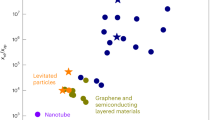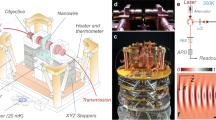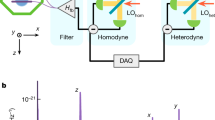Abstract
Nano- and micromechanical oscillators with high quality (Q)-factors have gained much attention for their potential application as ultrasensitive detectors. In contrast to micro-fabricated devices, optically trapped nanoparticles in vacuum do not suffer from clamping losses, hence leading to much larger Q-factors. We find that for a levitated nanoparticle the thermal energy suffices to drive the motion of the nanoparticle into the nonlinear regime. First, we experimentally measure and fully characterize the frequency fluctuations originating from thermal motion and nonlinearities. Second, we demonstrate that feedback cooling can be used to mitigate these fluctuations. The high level of control allows us to fully exploit the force-sensing capabilities of the nanoresonator. Our approach offers a force sensitivity of 20 zN Hz−1/2, which is the highest value reported so far at room temperature, sufficient to sense ultraweak interactions, such as non-Newtonian gravity-like forces.
This is a preview of subscription content, access via your institution
Access options
Subscribe to this journal
Receive 12 print issues and online access
$209.00 per year
only $17.42 per issue
Buy this article
- Purchase on Springer Link
- Instant access to full article PDF
Prices may be subject to local taxes which are calculated during checkout





Similar content being viewed by others
References
Chaste, J. et al. A nanomechanical mass sensor with yoctogram resolution. Nature Nanotech. 7, 301–304 (2012.).
Yang, Y. T., Callegari, C, Feng, X. L., Ekinci, K. L. & Roukes, M. L. Zeptogram-scale nanomechanical mass sensing. Nano Lett. 6, 583–586 (2006).
Cleland, A. N. & Roukes, M. L. A nanometre-scale mechanical electrometer. Nature 392, 160–162 (1998).
Rugar, D., Budakian, R., Mamin, H. J. & Chui, B. W. Single spin detection by magnetic resonance force microscopy. Nature 430, 329–332 (2004).
Stipe, B. C., Mamin, H. J., Stowe, T. D., Kenny, T. W. & Rugar, D. Noncontact friction and force fluctuations between closely spaced bodies. Phys. Rev. Lett. 87, 096801 (2001).
Moser, J. et al. Ultrasensitive force detection with a nanotube mechanical resonator. Nature Nanotech. 8, 493–496 (2013).
Postma, H. W. Ch., Kozinsky, I., Husain, A. & Roukes, M. L. Dynamic range of nanotube- and nanowire-based electromechanical systems. Appl. Phys. Lett. 86, 223105 (2005).
Cleland, A. N. & Roukes, M. L. Noise processes in nanomechanical resonators. J. Appl. Phys. 92, 2758–2769 (2002).
Ekinci, K. L., Yang, Y. T. & Roukes, M. L. Ultimate limits to inertial mass sensing based on nanoelectromechanical systems. J. Appl. Phys. 95, 2682–2689 (2004).
Ashkin, A. Optical levitation by radiation pressure. Appl. Phys. Lett. 19, 283–285 (1971).
Gieseler, J., Deutsch, B., Quidant, R. & Novotny, L. Subkelvin parametric feedback cooling of a laser-trapped nanoparticle. Phys. Rev. Lett. 109, 103603 (2012).
Li, T., Kheifets, S. & Raizen, M. Millikelvin cooling of an optically trapped microsphere in vacuum. Nature Phys. 7, 527–530 (2011).
Romero-Isart, O., Juan, M. L., Quidant, R. & Cirac, J. I. Toward quantum superposition of living organisms. New J. Phys. 12, 033015 (2010).
Chang, D. E. et al. Cavity opto-mechanics using an optically levitated nanosphere. Proc. Natl Acad. Sci. USA 107, 1005–1010 (2010).
Epstein, P. S. On the resistance experienced by spheres in their motion through gases. Phys. Rev. 22, 710–733 (1923).
O’Hanlon, J. F. A User’s Guide to Vacuum Technology 3rd edn (Wiley, 2003).
Dykman, M. I. & Krivoglaz, M. A. Theory of nonlinear oscillator interacting with a medium. Phys. Rev. 5, 265–441 (1984).
Lifshitz, R. & Cross, M. C. Review of Nonlinear Dynamics and Complexity (Wiley-VCH, 2009).
Dykman, M. I., Mannella, R. R., McClintock, P. V. E., Soskin, S. M. & Stocks, N. G. Noise-induced narrowing of peaks in the power spectra of underdamped nonlinear oscillators. Phys. Rev. A 42, 7041–7049 (1990).
Neukirch, L. P., Gieseler, J., Quidant, R., Novotny, L. & Nick Vamivakas, A. Observation of nitrogen vacancy photoluminescence from an optically levitated nanodiamond. Opt. Lett. 38, 2976–2979 (2013).
Geiselmann, M. et al. Three-dimensional optical manipulation of a single electron spin. Nature Nanotech. 8, 175–179 (2013).
Zurita-Sánchez, J., Greffet, J-J. & Novotny, L. Friction forces arising from fluctuating thermal fields. Phys. Rev. A 69, 022902 (2004).
Knünz, S. et al. Injection locking of a trapped-ion phonon laser. Phys. Rev. Lett. 105, 013004 (2010).
Arvanitaki, A. & Geraci, A. A. Detecting high-frequency gravitational waves with optically levitated sensors. Phys. Rev. Lett. 110, 071105 (2013).
Villanueva, L. G. et al. Surpassing fundamental limits of oscillators using nonlinear resonators. Phys. Rev. Lett. 110, 177208 (2013).
Mertz, J., Marti, O. & Mlynek, J. Regulation of a microcantilever response by force feedback. Appl. Phys. Lett. 62, 2344–2346 (1993).
Seifert, F., Kwee, P., Heurs, M., Willke, B. & Danzmann, K. Laser power stabilization for second-generation gravitational wave detectors. Opt. Lett. 31, 2000–2002 (2006).
Geraci, A. A., Papp, S. B. & Kitching, J. Short-range force detection using optically cooled levitated microspheres. Phys. Rev. Lett. 105, 101101 (2010).
Acknowledgements
This research was funded by ETH Zurich, Fundació Privada CELLEX, ERC-QMES (No. 338763) and ERC-Plasmolight (No. 259196). We thank A. Bachtold and M. Spasenović for valuable input and help and Iñaki Gonzalez for his assistance in preparing Fig. 1.
Author information
Authors and Affiliations
Contributions
J.G. and L.N. developed the set-up. J.G. performed the experiments and analysed the data. L.N. and R.Q. supervised the work. All authors contributed to discussing the results and writing the manuscript.
Corresponding authors
Ethics declarations
Competing interests
The authors declare no competing financial interests.
Supplementary information
Supplementary Information
Supplementary Information (PDF 1781 kb)
Rights and permissions
About this article
Cite this article
Gieseler, J., Novotny, L. & Quidant, R. Thermal nonlinearities in a nanomechanical oscillator. Nature Phys 9, 806–810 (2013). https://doi.org/10.1038/nphys2798
Received:
Accepted:
Published:
Issue Date:
DOI: https://doi.org/10.1038/nphys2798
This article is cited by
-
Nonlinear nanomechanical resonators approaching the quantum ground state
Nature Physics (2023)
-
Nanoscale feedback control of six degrees of freedom of a near-sphere
Nature Communications (2023)
-
Nonlinear multi-frequency phonon lasers with active levitated optomechanics
Nature Physics (2023)
-
Displacement Calibration of Optical Tweezers With Gravitational Acceleration
Photonic Sensors (2023)
-
Stroboscopic thermally-driven mechanical motion
Scientific Reports (2022)



